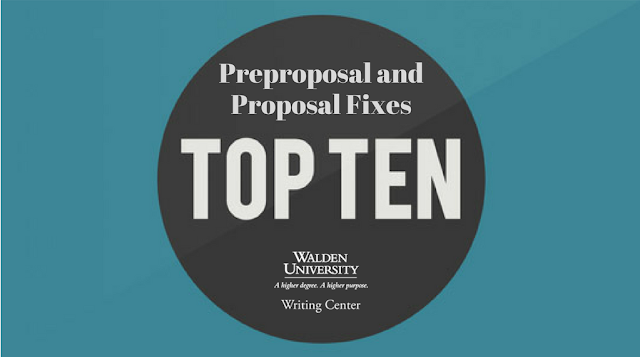Top 10 Preproposal and Proposal Fixes for Capstone Writers: Part II
Last week, we began our presentation on top fixes for those working on capstone projects here at Walden University. We made recommendations to writers about streamlining language use to capture an effective scholarly voice. Today, we are pleased to present the rest of our suggestions that cover topics like how to consider your reader as you write and how to review APA errors as you revise. The strategies we present today come from years of working with Walden capstone writers in the preproposal and proposal stages of their programs. We're happy to share what we've learned with you today!Fixes 4-6: Keeping Your Reader In Mind
4. Try to avoid ending sections with a citation (unless
explicitly required by your program). Instead focus on your project. Claire
often notes that in preproposal documents the significance or other sections
end with a piece of evidence. However, since the purpose of your work should be
unique (no one else has done this particular study before), inclusion of a
citation at the end of a section gives me as a reader the wrong emphasis. For
clarity and flow, I always recommend trying to refocus readers on your project
at the end of sections where possible.
5. Students writing a doctoral study or dissertation should make
sure that key terms are defined appropriately and helpfully. Readers (and you!)
need to be clear about the operational and conceptual definitions used in your
document. When composing and revising this section of your study, first ask
yourself whether the list includes all of the terms a reader needs to understand
to follow your argument. Then, scrutinize the definitions to make sure that
they are succinct and sufficiently descriptive and that they provide readers
with clear definitions of terms as they are used in your study. Support your
definitions with appropriate citations. Remember to arrange definitions in
ascending alphabetical order (A, B, C, D, etc.) and indent them like
paragraphs. In addition, definitional terms should be italicized and in
sentence case and followed by a nonitalicized colon.
6. Be sure to follow APA guidelines for abbreviations. This fix
relates to keeping your reader in mind because abbreviations are meant to help
out your reader—you want to abbreviate terms you’ll be using over and over and
find a helpful and clear abbreviation to use to assist readers. You want to be
consistent and to follow APA style specifications. Sometimes, inclusion of
abbreviations can be distracting and unhelpful to readers, particularly if many
abbreviations are used within a sentence or paragraph. Readers are also
distracted by the inconsistent use of abbreviations in a text (e.g., an
abbreviation is introduced, but the full term is used in subsequent sentences). See
also: our webpage on APA abbreviations.
Fixes 7-10: Review APA Errors as You Revise
7. Ensure that “References” at the beginning of your reference
section is centered, flush left, but not bold. Per APA, References is treated
as a title rather than a heading for formatting. See APA, p. 62, for a helpful
overview of how to format headings in APA. For doctoral capstone writers, the Form and Style Review Checklist also includes a quick and easy-to-grasp overview of
headings.
8. Don’t list the
library or a database as your source URL. A reader who isn’t a Walden student
or who does not have access to a certain database can’t use a database URL.
Instead, first search for the doi number. If there is no doi number, then type the name of the
journal/source into Google. Find that source’s Internet homepage and copy and
paste the homepage link after “retrieved from” in your reference (be sure to
undo the automatic hyperlink).
9. Make sure your
reference list and sources in your document match. You’ll work on these
documents over a long period of time, so having some sources that are cut or
never used is understandable! But not having a reference entry for a source a
reader wants to look up, or listing a source you never reference, is confusing
to the reader, so be sure to double check.
10. Check that you’ve
used & and “and” correctly in your citations. If a citation is in
parentheses (or in your reference list), always use “&”—think of it as a
shorthand. If you’ve referenced the authors as part of the meaning of the
sentence, spell out “and” as this is part of your larger text. See also: additional citation resources.
We are confident that making the fixes we’ve
identified will strengthen your doctoral study and make your experience more
enjoyable. The preproposal stage is a great time to start using this list. In
the comments box, be sure to share whether you have your own list of easy fixes
for capstone proofreading and revising.
Claire Helakoski is a Writing Instructor and Tara Kachgal is a Dissertation Editor in the Walden University Writing Center. Both are dedicated to supporting writers as the begin, progress, and complete their capstone projects.
.png)
Never miss a new post; Opt-out at any time
Subscribe to:
Post Comments
(
Atom
)






I need help to provide a definitive ending on my problem statement. I tried so many times to rephrase, reword or change the statement entirely but it does not seem to work. Can someone help me on this particular issue. I am on the second term of capstone study.
ReplyDeleteLizabeth Hofschneider
STUDENT ID: A00554524